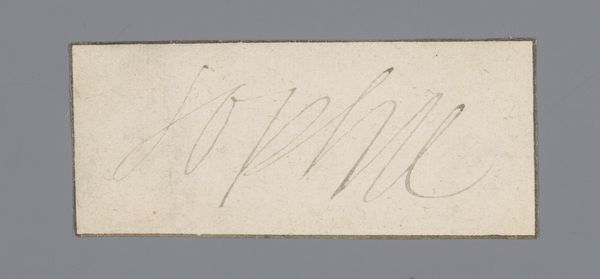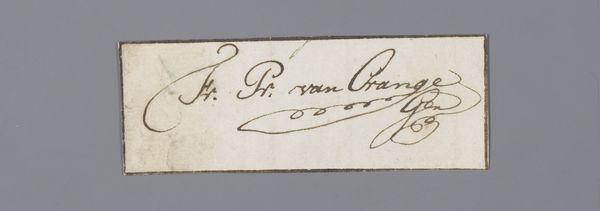
drawing, paper, ink
#
portrait
#
drawing
#
baroque
#
paper
#
ink
#
historical font
#
calligraphy
Dimensions: height 3.1 cm, width 10.6 cm
Copyright: Rijks Museum: Open Domain
Curator: Here we have a document from the late 18th century, sometime between 1720 and 1788, held at the Rijksmuseum. It’s identified as a portrait of Ludwig Ernst von Braunschweig-Wolfenbüttel. It’s ink on paper. Editor: My initial impression is one of restraint, a contained energy within the meticulous curves and precise strokes. It's monochrome palette further contributes to its sense of austerity, an understated formality. Curator: Yes, Baroque calligraphy can appear so formal now, yet there's an undeniable expressive quality. Notice how the flourishing strokes extend beyond pure legibility, suggesting the status and personality of the portrayed figure. Script was often considered as much a symbol of identity as a painted portrait. Editor: Absolutely. And it's within those very flourishes where the artistic gesture becomes apparent. Look at how the calligrapher varies the line weight to create depth and shadow—the heavier strokes ground the piece, while the thinner lines lift the composition. Curator: In its own way, it embodies a shift towards enlightenment ideals: reason, but ornamented by tradition. The handwriting represents a personal and a public statement. Writing and literacy itself would be increasingly tied up with the idea of a governing class. Editor: Indeed. And let's consider the surface, the ground for the marks: the paper itself is a critical component, the negative space equally contributing to the harmony. The artist clearly understood the semiotic interplay between line and surface, substance and void. Curator: For the person viewing this at the time, the handwriting alone would probably carry all the emotional and contextual weight we might now project upon a full portrait or historical document. Editor: A fascinating micro-portrait, if you will—minimal yet highly evocative. Considering it as a formal study offers some insight into how less might convey even more in the eye of the beholder.
Comments
No comments
Be the first to comment and join the conversation on the ultimate creative platform.













